- Offensive Techniques & Strategies

Part 2: Offensive Rebounding
What to Discover or Recall . . .
Second and third efforts are vital. You are not going to win many games if you only get one shot.
Offensive rebounding is an individual effort requiring anticipation, determination, and hustle.
Offensive rebounders can establish inside position by boxing out the defensive players.
Players must develop an attitude as well as an instinct for the ball.
Shot selection also plays a vital role in offensive rebounding.
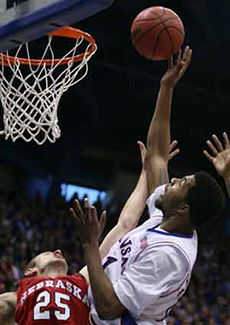
A Missed Shot Should Result In A Good Pass
| Attitude | Techniques | Team Work | Defensive Balance | 2nd Efforts | Review | Drills |
The importance of offensive rebounding to the outcome of the game cannot be over emphasized. Simply stated, even if you shoot well, it is going to be very difficult to win if you get only one shot. Rather than size and strength that is required for defensive rebounding, offensive rebounding requires anticipation, determination, and hustle. They must be aggressive and determined, and 3rd and 4th efforts should be common place to offensive rebounding.

Players must develop an attitude as well as an instinct for the ball.
Anticipation
Establish Rebounding Position Prior to the Ball Hitting the Rim!
The most important key to offensive rebounding is getting to the right place at the right time. In order to accomplish this, players must be active during FLIGHT TIME (the time it takes the ball to leave the shooter's hand, hit the rim, bounce to its highest point, and descend to a point where it can be rebounded). During this time players must determine distance as well as the proper angle of rebound. However, close to 70% of the time shot will rebound off to opposite side of basket. Also, the longer the shot the longer the rebound.
Agility
Once in the rebounding area, players then need to establish inside position by boxing out the defender and avoid going over the back of the defensive player. They must be able to out maneuver the defensive player. Against a good defensive box out, players should be skilled in using the arm over and spin techniques to get inside. However, in establishing inside position, they should be careful not to get caught too far under the basket. Also, in situations where actual possession cannot be achieved, they should keep the ball alive by tipping it to a teammate or away from any defensive players.
Shot Selection
Shot selection also plays a vital role in offensive rebounding. Not much can be done in the way of offensive rebounding when the shooter takes a bad shot. In situations where good shots are taken, a missed shot will result in a good pass to an offensive rebounder. Although, shooting percentages do reflect shot selection tendencies, it really does matter how many shots it takes on a possession as long as you score.

Offensive Rebounding Moves
Boxing Out the Defender
Offensive rebounding requires that the offensive players establish inside position by boxing out the defensive players. In most shots, since players have a tendency to watch the flight of the ball and do not box out, all the offensive player has to do is simply step around the defender to establish inside rebounding position. However, in cases, where defenders do block out, offensive players need to know how to use arm over and spin techniques to get inside.

| Step in Front | Arm Over/Step Over | Spin Move | Keeping Ball Alive |
 Step in Front
Step in FrontOn most shots, defenders watch the flight of the ball and do not box out. Therefore, all an alert offensive player can take full advantage of this simply by stepping in front of the defender and boxing them out.
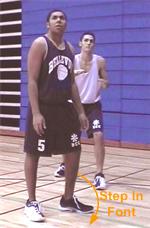
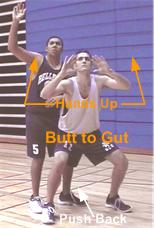
 Arm Over/Step Over Move
Arm Over/Step Over MoveIn cases where the defender does make an attempt to box out, the offensive player should deploy an Arm Over/Step Over move to establish inside position.
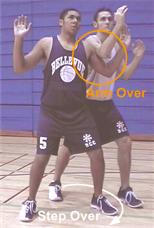
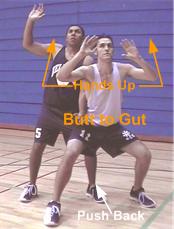
In executing the Arm Over move, the offensive player uses the upper portion of their opposite arm to knock the opponent's arm down as they step in front of the defender using a cross over step. Once in front, the same hands up - "butt to the gut" technique as in defensive rebounding is used to box out the defender.
 Arm Over/Spin Move
Arm Over/Spin MoveIn situations where the defender, is extremely good rebounder, and maintains inside position by countering the Arm Over/Step Over move, the offensive player should then execute a quick spin move back in the opposite direction.
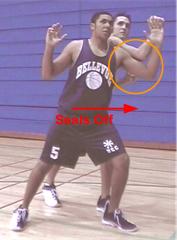
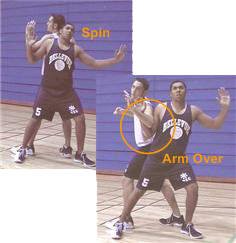
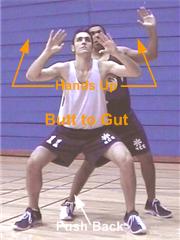
When a really good defender fights off the "Arm Over/Step Over" move by moving their feet and sliding in the same direction, the offensive player should counter by quickly spinning back in the opposite direction and executing the "Arm Over/Step Over" move with the opposite arm. Once in front, maintain inside position by spreading out with both hands high. Strive to maintain inside position, but be careful not to get push too far under.
 Keep the Ball Alive
Keep the Ball AliveIn situations when actual ball possession cannot be achieved, keep the ball alive by tipping it to a teammate or away from any defensive players.

Offensive Rebounding - Team Work
Individual Effort Coordinated within a Team Effort
Players can screen during "Flight Time" to free up teammates especially against teams that box out well and on free throw situations. In almost all cases, both offensive players will wind up with inside rebounding position.

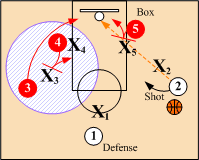
Wing Back Screen
On the shot, O4 steps out and sets a back screen for O3. O3 goes baseline as O4 rolls and rebounds to the middle. If the defense switches, O3 crashes to the middle and O4 rolls to the baseline boxing out smaller defender X3.
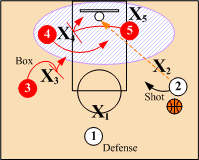
Base Cross Screen
As the ball is shot, post O5 screens across for O4 on shot. O4 flashes into the middle while O5 boxes out and rebounds against smaller defender X4 on a weakside mismatch.
Offensive Rebounding on a Free Throw Throw Situation
Obtaining an offensive rebound off a missed free throw is a "Really Big Play" (RBP). Offensive rebounds on free throw situations become especially paramount at the end of the game. If behind, an offensive rebound will provide a team with another chance to catch up. If ahead, they will allow a team to run off additional clock, denying the opponents any opportunity to catch up.
On free throw situations, in addition to individual offensive techniques, players can use teamwork and stunts such as "Cross" and "Duck." to establish inside rebounding position.
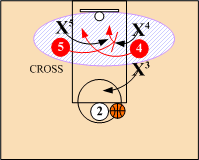
"Cross"
As free throw is shot, O5 screens across for O4. O4 flashes across to opposite side while O5 boxes out and rebounds against smaller defender X4 on a weakside mismatch.
Using body language communication, O4 can also screen across for O5.
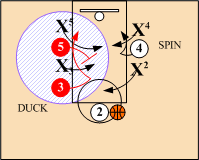
"Duck"
O5 steps up the lane and sets a back screen for O3. O3 goes to basket off O5's screen.
CAUTION
Chances are good during the season that an end of game situation will be encountered that requires the intentionally missing of a free throw. Therefore, teams must be prepared for it. Intentional missing a free throw must be taught and practiced. Players must know and recognize their assignments are on a "intentionally" missed free throw situation. Shooters must not only practice the intentional miss, they also need to be aware of the rule that the ball must hit the rim.

Maintaining Defensive Balance
Although offensive rebounding is mainly dependent on individual effort, this individual effort must take place within the confines of a well coordinated team effort. Obviously, if all five offensive players try to the boards there will be no one back to protect against the opponent's fast break or early push.

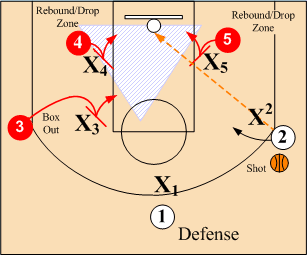
Basically, offensive rebounding entails establishing a rebounding triangle (with inside position) along with defensive balance. Normally on a shot, 3 1/2 players will attack the offensive boards and 1 1/2 players have defensive responsibility. In situations where the opponent is not a threat to run or push the ball, you can pound the boards with four and half players. At other times, when the opponent's pushes the ball hard, 2 1/2 or even 3 1/2 players may have to assume defensive balance roles.
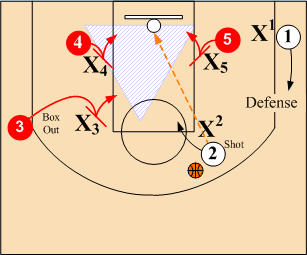
In maintaining defensive balance, however, the offensive player with defensive responsibility does not necessarily have to be standing near the mid court. As long as they are moving toward half court, the player with defensive responsibility can even be located on the baseline when the shot is taken. In most situations, the off guard will have primary defensive responsibility allowing the point guard to attack and disrupt any outlet passes.
Changing Roles & Responsibilities
Since, offensively, players will be in constant motion, it is vital that they know their offensive rebounding and defensive responsibilities at all times. These roles should be pointed out and clarified on every option of every offensive set. Players must also be alert that their offensive rebounding roles may change on dribble penetration.
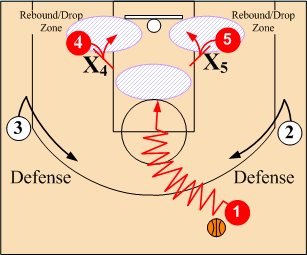
Rebound/Drop ZonesOn dribble penetration, in most cases, the wings will be responsible for maintaining defensive balance. Also, on any dribble penetration, the baseline players must establish "Rebound/Drop zones." This will allow for the penetrating player to make a drop pass if/when a baseline defender should step out to help out on against the drive. It also allows the offensive players to "Box Out" the defensive players for easy putbacks on missed shots.

Rebound Shots & Second Efforts
Finish - You Must Score To Be Successful!
In order for offensive rebounding to be successful you must score. Points scored on second efforts is an important statistic. You can get all the offensive rebounds you want, but it you do not convert them to points they are of little value. Easy putback shots off missed shots not only puts points on the scoreboard, but are also very demoralizing to the opponent as well.
Most players do not spend much time working on the tipping ability. However, to be successful around the boards, you must be able to tip the ball accurately using either hand. Tipping off the backboard or wall should be incorporated into every player's daily warm up. Not only will it improve tipping ability, but in addition, will warm up the hands, fingers and calf muscles. Tipping is also important for timing. All the jumping ability in the world is useless if the jump is too soon or too late.On Putbacks or Rebound Shots quickness is vital. On putbacks, you must rebound the ball with both arms outstretched over head, land on the floor and quickly bounce back up and put the ball off the glass into the basket without bringing the ball down. Not bringing the ball down is paramount. Be careful to establish inside position without being pushed too close to the basket. When the ball is rebounded near or under the basket, players must expose the ball overhead on the rebound shot providing the defenders a good opportunity to block it.
NOTE: During a game, if the tip or putback is not immediately available you should make a kick out pass and get open for a return pass rather than risk having the shot blocked.

In Review
A missed shot should result in a good pass.
It is going to be very difficult to win if you get only one shot.
Rather than size and strength that is required for defensive rebounding, offensive rebounding requires anticipation, determination, and hustle.
Players must develop an attitude as well as an instinct for the ball.
Offensive rebounders can establish inside position by boxing out the defensive players.
Players can set screens to free up teammates especially against teams that box out well.
When actual ball possession cannot be achieved, offensive rebounders should keep the ball alive by tipping it to a teammate or away from any defensive players.
-
Maintaining defensive balance is critical in offensive rebounding.
Shot selection also plays a vital role in offensive rebounding.
In order for offensive rebounding to be successful you must score.

Drills for Skills
Players spend a lot of time working on outside shooting and drives but spend little or no time practicing shots in the paint (3 second area). However, in a game point blank shots cannot be missed and, therefore, must be practiced. On short shots, if at all possible, use the glass since bank shots are the easiest shots in the game. Offensive rebounding drills that will improve players' tipping and jumping abilities:
Related Links:
© 2026 HoopTactics All Rights Reserved.

